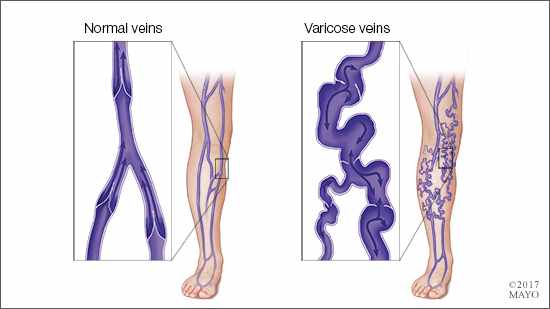-
Featured News
Could leg pain be due to varicose veins?

LA CROSSE, Wis. ― Patients experiencing an achy, heavy feeling or a burning sensation in their legs may be feeling the symptoms of varicose veins. These twisted, enlarged veins often develop as people age, but they also can begin when people are younger. Any vein that is close to the skin's surface — called a superficial vein — can become a varicose vein.
"For most people, varicose veins simply are a cosmetic concern," says Christopher Huiras, M.D., a general and vascular surgeon at Mayo Clinic Health System in La Crosse and Sparta. "But for others, varicose veins may lead to more serious health issues, such as significant life-limiting ulcers or blood clots."
Dr. Huiras says symptoms of varicose veins include:
- Muscle cramping and swelling in the lower legs.
- Worsened pain after sitting or standing for a long time.
- Itching, pain or heat around one or more veins.
- Skin ulcers near the ankle.
Varicose veins are usually dark purple or blue in color, and they tend to appear twisted or bulge.
"Exercising, limiting sodium intake, losing weight and elevating your legs are some self-care options to stop varicose veins from worsening," explains Dr. Huiras. "Purchasing compression stockings often is the first approach your health care team will suggest before trying other treatment options."
Compression stockings can be worn during the day to improve blood flow in the legs, and reduce swelling and aching.
If these self-care options don't ease the pain, Dr. Huiras says options that might provide quick recovery with minimal pain include:
- Sclerotherapy
In this procedure, a health care professional injects varicose veins with a solution that scars and closes the veins. This can be done with laser energy without needles. - Minimally invasive catheter-assisted procedure
In this procedure using radiofrequency ablation or laser energy, a long, thin tube is placed into the vein and the tip is heated. This destroys larger veins by causing them to collapse and close. - Vein stripping
In this procedure, a limited piece of vein is removed through small incisions on the leg. Removing the vein won't keep blood from flowing in the leg because veins deeper in the leg take care of the larger volumes of blood. - Ambulatory phlebectomy
This procedure, which is performed in a health care professional's office, is less invasive than vein stripping. "Smaller varicose veins are removed through a series of tiny skin punctures," says Dr. Hurias. "Only the parts of the leg that are being pricked are numbed. It's also performed in the operating room with the help of sedation or other anesthesia for more extensive vein removal." - Endoscopic vein surgery
This surgery usually is used for advanced cases where leg ulcers are present.
"Sometimes, one or more procedures can be combined for best results," Dr. Huiras says.
###
About Mayo Clinic Health System
Mayo Clinic Health System consists of clinics, hospitals and other facilities that serve the health care needs of people in Iowa, Minnesota and Wisconsin. The community-based providers, paired with the resources and expertise of Mayo Clinic, enable patients in the region to receive highest-quality physical and virtual health care close to home.
About Mayo Clinic Health System in La Crosse
Mayo Clinic Health System in La Crosse was the only health care facility in Southwest Wisconsin in 2021 that received the Centers for Medicare & Medicaid's 5-Star Quality Rating and Leapfrog Grade A for Safety, and was named in Healthgrades America's "250 Best Hospitals" and Newsweek's "Best Hospitals in the U.S."
Media contact:
- Rick Thiesse, Mayo Clinic Health System Public Affairs, 608-392-9435, thiesse.ricky@mayo.edu







